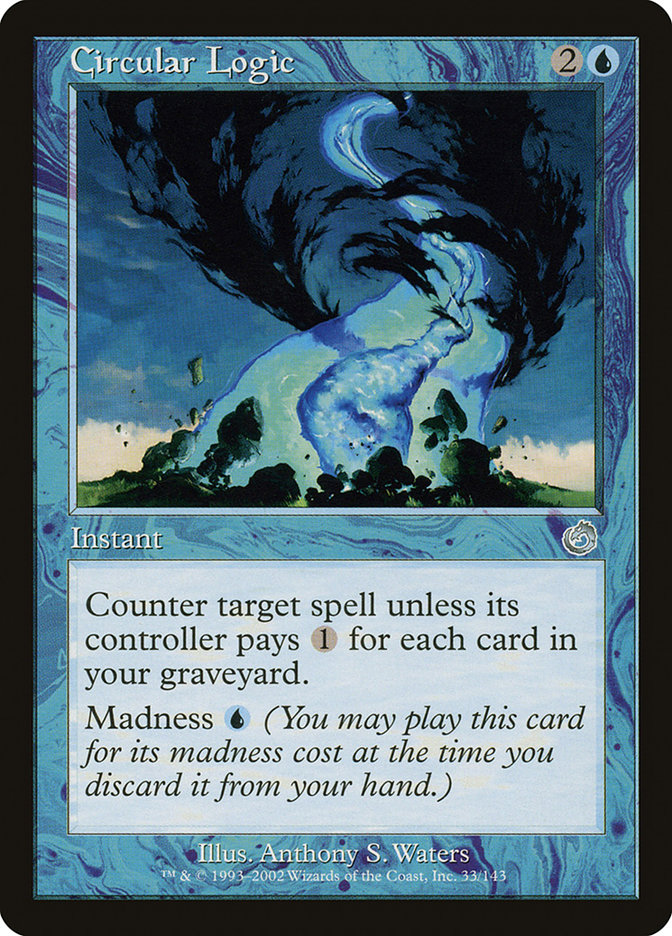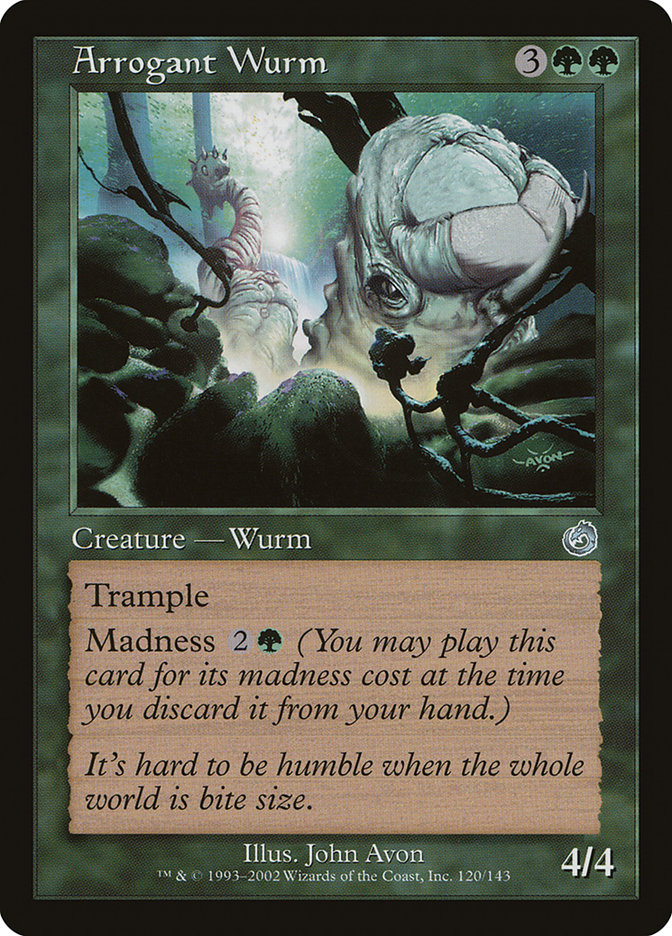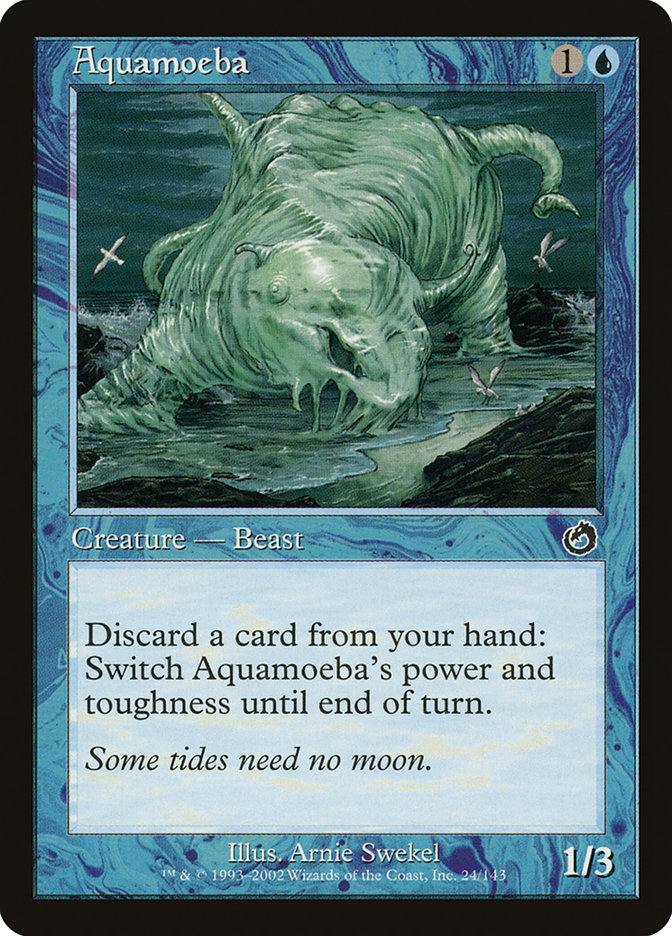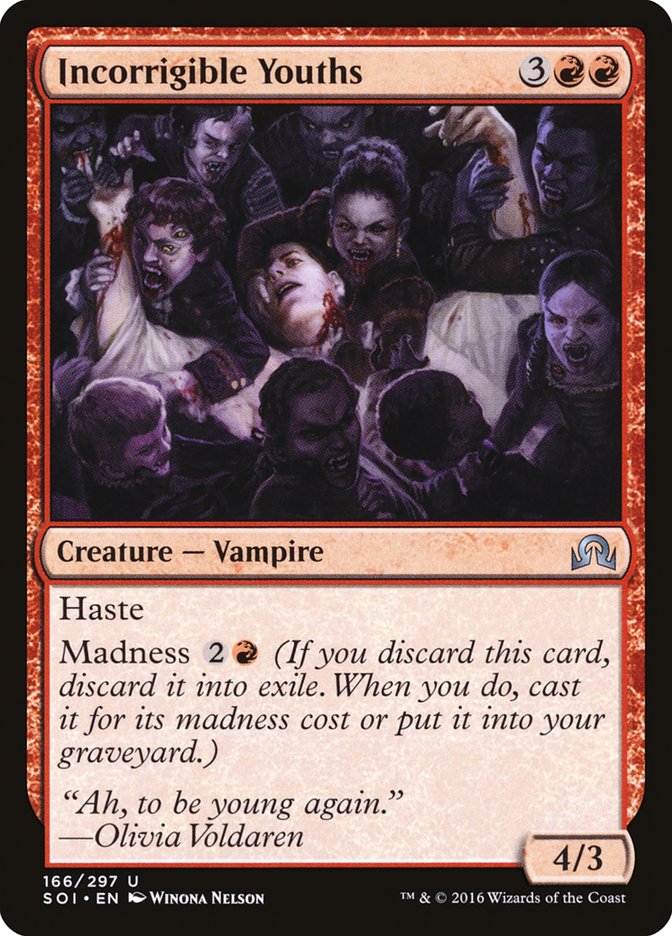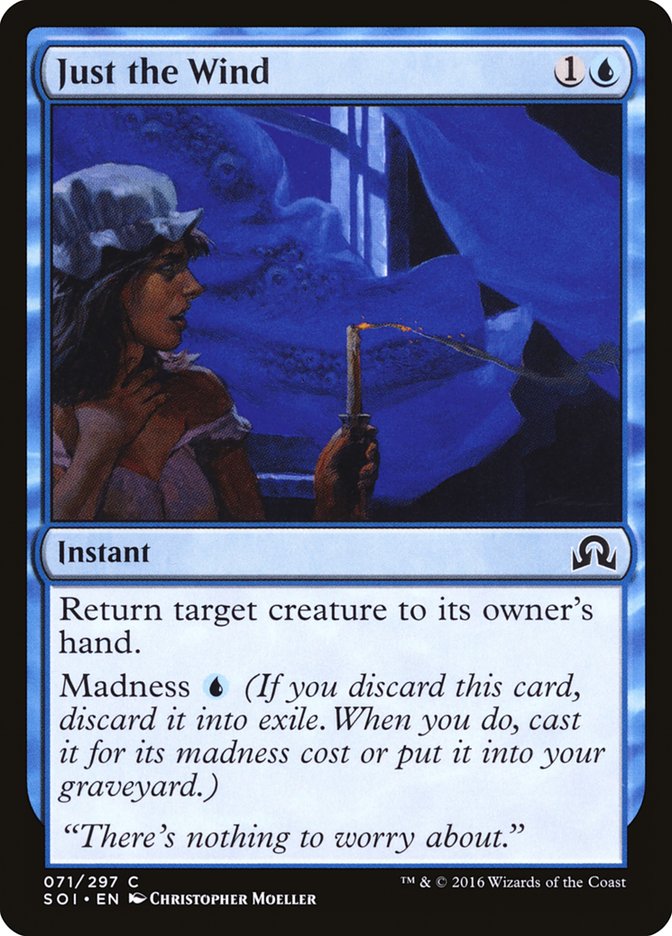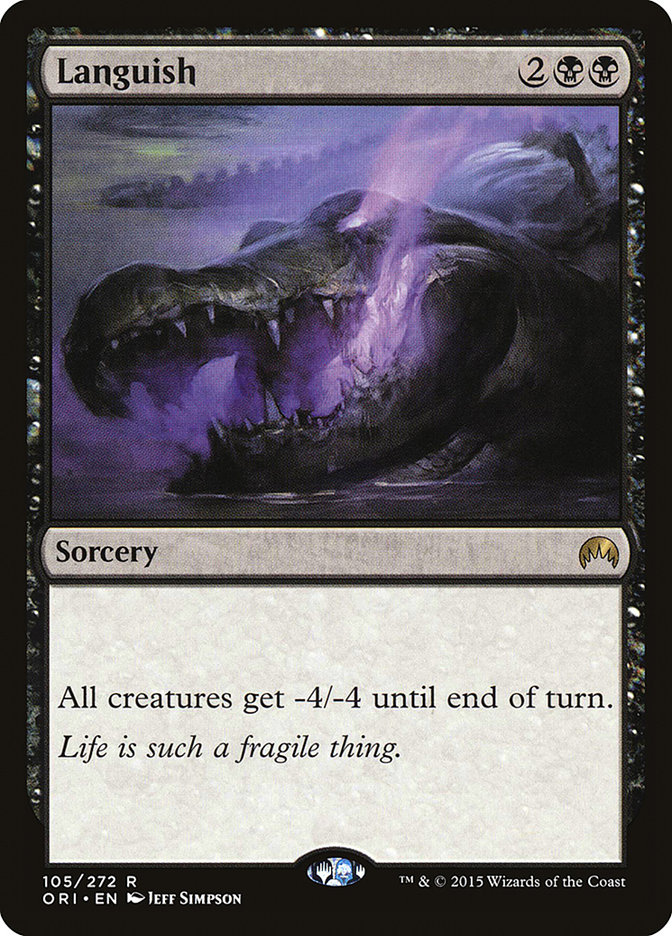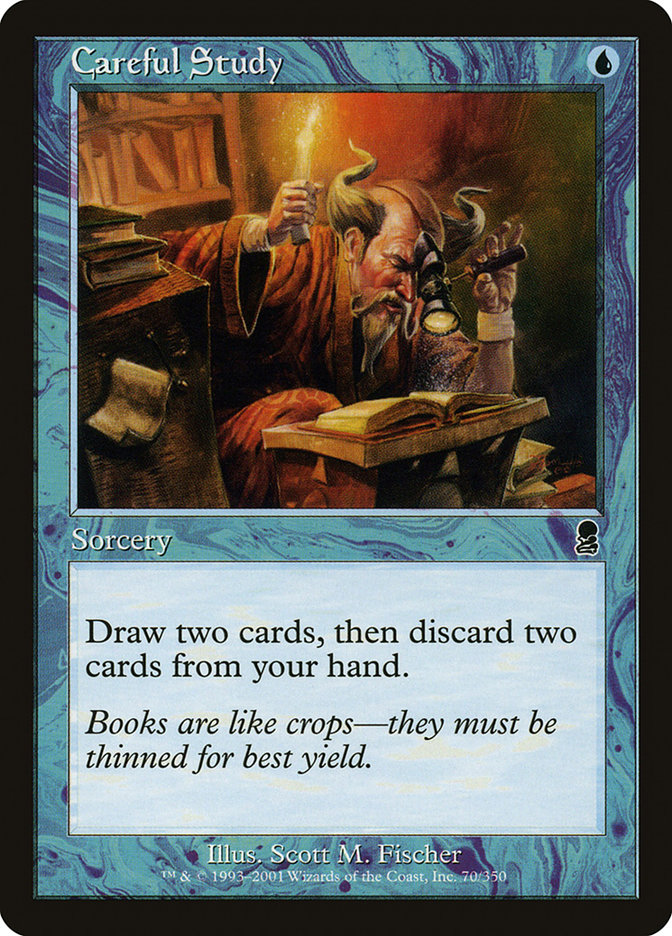Back when I first started playing Magic, my local store ran its Friday Night Magic unsanctioned. While this was great for a kid like me, since I was allowed to proxy a few expensive cards in my deck if necessary, it left me without a DCI card when I went to register for my first big tournament, Regionals.
As such, it is that tournament that I look back on as my first foray into competitive Magic and as such it holds a special place in my memory. The deck I registered in that tournament? U/G Madness:
Creatures (18)
Lands (22)
Spells (20)

This list is from a little later in the year from when I played, and I had a few copies of Merfolk Looter in my deck, but it is highly representative of what these lists looked like. For those of you who weren’t playing back then, U/G Madness was an archetypal aggro-control deck. The madness mechanic allowed you to play undercosted threats and gain tempo with cards like Circular Logic and Unsummon.
For a middle/high school student like me, this deck was a perfect entry point to competitive Magic because it was dirt cheap. When the deck originally emerged during Invasion–Odyssey Standard, the most expensive card in the deck was Yavimaya Coast, which, if memory serves, was about seven dollars. Throw in plenty of cool foil basic lands (I was young and dumb) and I could compete at FNM. I have often said over the years that my path with Magic may have been very different had the economics of the game been as they are today.
But I am not here to lament the startup capital necessary to enter competitive Magic. I am here because Wizards has finally offered me the opportunity to relive my Magic youth because madness is coming back! So today, in a misguided attempt to recapture my lost youth, I am going to run through some of the key cards that have been spoiled so far that could fit into a madness deck.
The obvious parallel to this card is Aquamoeba. The first discarded card has the same effect, changing the creature from a 1/3 to a 3/1, but from there Ravenous Bloodseeker has a significant downside.
A second card discarded on the same turn will turn it into a 5/-1, earning it a one-way ticket to the graveyard. One of the keys to being an effective aggro-control deck is managing tempo well and be able to cast two spells on key turns. Given that the madness mechanic offers you a significant discount on your cards, being able to cast two discounted spells on one turn would provide a significant advantage, but losing your enabler in the process is quite the sacrifice to make.
Still, this is a solid rate on an aggressive creature and should be an immediate consideration for any madness deck. Note that, back in Aquamoeba’s day, one of the benefits of being able to discard multiple cards at once was to take advantage of damage going on the stack. Once in combat, you could discard a card to make Aquamoeba a 3/1, put damage on the stack, and then discard a second card to make it a 1/3. In this way, Aquamoeba could function more like a 3/3 for two mana, always a solid rate.
Without this benefit, the downside of Ravenous Bloodseeker is minimal, and you can turn it into an advantage with some way to pump the Bloodseeker’s toughness.
Moving on, we have another card with a close analog from U/G Madness, Arrogant Wurm. Curving Wild Mongrel or Aquamoeba into Arrogant Wurm was a strong opening curve that would put you solidly ahead, thus making tempo cards like Unsummon and Circular Logic more effective. I can easily see the Ravenous Bloodsucker – Incorrigible Youths curve functioning in the same vein, as a seven-point attack on turn 3 is impressive to say the least.
The haste on Youths means that the new incarnation of madness decks may tilt more aggressive than the old green lists, especially if the focus on madness in red brings it some undercosted burn for added reach.
The proliferation of 2/3s in Standard is also good for the Incorrigible Youths, since the Youths will attack into 2/3s with impunity. Reflector Mage could be worrisome for a three-mana creature with no immediate battlefield impact outside of its body, but the haste on Youths will mean you get an attack in before they can return it to your hand. The madness ability means you can recast the creature on their next turn to regain some lost battlefield position so that you do not fall too far behind. Casting a 4/3 haste creature to play defense may seem strange, but options are always good.
If Unsummon seemed like a strange card to see in a competitive decklist, then maybe my excitement over this card would be similarly unwarranted. But Unsummon was actually a key card in the old U/G Madness deck, and not just because it matched up so well against Roar of the Wurm. Unsummon on the whole was wildly underappreciated until Vapor Snag and Snapcaster Mage ruled Standard a few years ago, at which point everyone collectively realized how large a tempo gain this one-mana spell could yield.
In recent years the Unsummon effect has been made a bit more expensive with cards like Force Away, but here we see a return to the classic. With the hard-hitting red creatures, a true Unsummon will be very effective, as each attack step can represent a huge chunk of your opponent’s life total. This card will be a key piece of any aggressively-oriented madness deck.
Just the Wind even lets Jace, Vryn’s Prodigy do its best Jace, the Mind Sculptor impression when you flash it back, as if the price tag wasn’t already reminiscent enough. Being able to loot with Jace, discard Just the Wind, flip the Jace, and flash it back for a double bounce will be a devastating turn that all of your opponents will have to be wary of, and the threat of it will cause overly conservative play that you can take advantage of.
And so we come to the $360 elephant in the room. In 2003 I could build the entire U/G Madness deck for less than the price of a single Jace, Vryn’s Prodigy, but having such a powerful card also be an enabler for madness will make the new iterations of the deck much more expensive. This is simply a reality of Magic today. The game is much more popular than it was back then, and with that popularity comes rising demand and rising prices for the best cards.
The good news is that the cards we have seen thus far are commons and uncommons, so overall this should not be a particularly expensive deck; it’s just that much of the cost is concentrated in its best cards.
I noted earlier that I played Merfolk Looter in my U/G Madness deck, and I see Jace taking a similar role, although the upside of Jace will turn it from a role player into a staple of the archetype. When you play a card with madness off a Jace loot, you have effectively drawn a card and gained tempo by playing your spell at a discount. Being able to gain in card advantage and tempo simultaneously is incredibly rare in Magic, so even though Jace itself does not pressure your opponent’s life total, it is an excellent fit in this deck, much in the same way the card slotted into U/R Prowess.
We have six more months of Jace, Vryn’s Prodigy in Standard, so settle in and learn to enjoy it.
These last two cards are interesting because they provide a strong incentive to play black in our madness deck. With more strong support and no conceivable way to support three colors with the loss of fetchlands, we could be heading toward a scenario where there are several different madness decks, all subsets of Grixis, in the early days of Shadows Standard.
Heir of Falkenrath looks similar at first glance to Ravenous Bloodseeker, a strong, aggressive two-drop that enables madness, but the fact that you can only activate it once can be awkward in a truly dedicated madness deck. You get the most value upfront, but going into the midgame, you will be drawing a lot of overcosted spells if you do not find another enabler.
But in a less dedicated build, curving Heir into Incorrigible Youths and following it up with generic, powerful cards could be a good direction to take the deck. You will have fewer degenerate draws but you will also make yourself less vulnerable to having the synergies of your deck picked apart by your opponent.
If you are looking for a second enabler for a black-based madness deck, then Elusive Tormentor is intriguing. This is a tricky card to evaluate because a lot of what it does is very subtle. On the surface, it is a four mana 4/4 that lets you discard cards for a low cost. Normally I would be skeptical of such a rate because I have been living in a Siege Rhino world for so long, but with the pesky pachyderm leaving Standard, this should be a fine rate. Still, we have to be worried about Reflector Mage. Fortunately, the ability on Elusive Tormentor provides some built-in protection, since transforming it into Insidious Mist means gaining hexproof.
This also allows Elusive Tormentor to protect itself from removal spells, so your enabler will be sure to stay on the battlefield and continue to offer a nice discount on your spells. Indestructibility even makes it immune from most sweepers, save Languish.
Last, you can use the transformation to save the creature in combat, making this an excellent way to stave off a large opposing creature, provided it does not have trample.
And once the Tormentor is transformed into Insidious Mist, we have a unique card that will be tough to evaluate in theory alone because there are so many corner cases with it. The obvious line is to attack with it and pay three mana to transform it back before damage is dealt to effectively make your enabler a 4/4 creature that cannot be blocked.
When following up some aggressive creatures, this is obviously very valuable, albeit mana-intensive. It is going to be difficult to constantly flip the card back and forth while also using it to cast your madness spells, so we should prepare for it to stay an Insidious Mist until we have the spare mana to flip it back.
Unfortunately, Insidious Mist does not block very well. Actually, it doesn’t block at all. It also doesn’t attack for much damage, well, zero to be precise. But with hexproof and indestructibility, we have a great target for auras and other pump spells to force through damage. You can even transform Insidious Mist and any auras, equipment, and counters will stay on it, since it is not becoming a new game object.
This gives any potential madness deck a very strong late-game threat that can completely dominate the battlefield with some help. I would follow the spoiler very closely for any cards that can help build Insidious Mist into a game-warping threat.
This also makes any black madness deck more of a midrange deck that can play reasonably in all phases of the game, so perhaps it would pair better with the power of Jace in blue than with the more aggressive bent of red. At this point, it is clear that a U/R version would be the most aggressive, followed by R/B and then B/U. It is important to keep this in mind when looking at later spoilers, and to evaluate new cards based on how well they fit each potential version. Maybe a later card is so powerful that it warps this initial understanding, but for now, I am comfortable working in this paradigm.
As more cards from Shadows over Innistrad are revealed, the complexion of a potential madness deck will only become clearer. Currently, I would wager on a U/R version becoming the best option, if only because the mana offered by enemy-colored pairs is significantly better than their friendly counterparts, with the added bonus of including a creature-land. But I wouldn’t be surprised if Wizards wanted to push madness into a different direction from the former U/G lists and intentionally pushed the power on some midrange and controlling cards with the mechanic.
I will certainly be looking out for how madness changes in this newest iteration, but the little kid inside of me just wants to discard two Basking Rootwallas to my Careful Study, so everyone cross your fingers for a Faithless Looting reprint!


